Noah Hollmann
Drift-Resilient TabPFN: In-Context Learning Temporal Distribution Shifts on Tabular Data
Nov 15, 2024
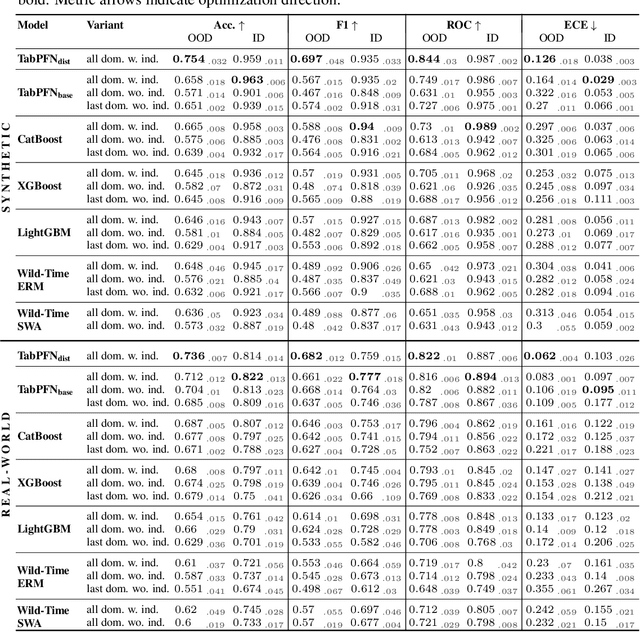


Abstract:While most ML models expect independent and identically distributed data, this assumption is often violated in real-world scenarios due to distribution shifts, resulting in the degradation of machine learning model performance. Until now, no tabular method has consistently outperformed classical supervised learning, which ignores these shifts. To address temporal distribution shifts, we present Drift-Resilient TabPFN, a fresh approach based on In-Context Learning with a Prior-Data Fitted Network that learns the learning algorithm itself: it accepts the entire training dataset as input and makes predictions on the test set in a single forward pass. Specifically, it learns to approximate Bayesian inference on synthetic datasets drawn from a prior that specifies the model's inductive bias. This prior is based on structural causal models (SCM), which gradually shift over time. To model shifts of these causal models, we use a secondary SCM, that specifies changes in the primary model parameters. The resulting Drift-Resilient TabPFN can be applied to unseen data, runs in seconds on small to moderately sized datasets and needs no hyperparameter tuning. Comprehensive evaluations across 18 synthetic and real-world datasets demonstrate large performance improvements over a wide range of baselines, such as XGB, CatBoost, TabPFN, and applicable methods featured in the Wild-Time benchmark. Compared to the strongest baselines, it improves accuracy from 0.688 to 0.744 and ROC AUC from 0.786 to 0.832 while maintaining stronger calibration. This approach could serve as significant groundwork for further research on out-of-distribution prediction.
Bayes' Power for Explaining In-Context Learning Generalizations
Oct 02, 2024Abstract:Traditionally, neural network training has been primarily viewed as an approximation of maximum likelihood estimation (MLE). This interpretation originated in a time when training for multiple epochs on small datasets was common and performance was data bound; but it falls short in the era of large-scale single-epoch trainings ushered in by large self-supervised setups, like language models. In this new setup, performance is compute-bound, but data is readily available. As models became more powerful, in-context learning (ICL), i.e., learning in a single forward-pass based on the context, emerged as one of the dominant paradigms. In this paper, we argue that a more useful interpretation of neural network behavior in this era is as an approximation of the true posterior, as defined by the data-generating process. We demonstrate this interpretations' power for ICL and its usefulness to predict generalizations to previously unseen tasks. We show how models become robust in-context learners by effectively composing knowledge from their training data. We illustrate this with experiments that reveal surprising generalizations, all explicable through the exact posterior. Finally, we show the inherent constraints of the generalization capabilities of posteriors and the limitations of neural networks in approximating these posteriors.
FairPFN: Transformers Can do Counterfactual Fairness
Jul 08, 2024

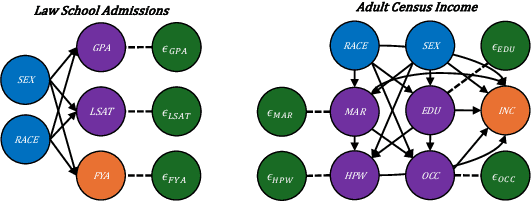
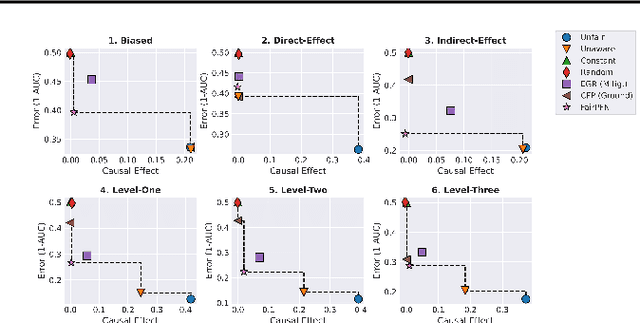
Abstract:Machine Learning systems are increasingly prevalent across healthcare, law enforcement, and finance but often operate on historical data, which may carry biases against certain demographic groups. Causal and counterfactual fairness provides an intuitive way to define fairness that closely aligns with legal standards. Despite its theoretical benefits, counterfactual fairness comes with several practical limitations, largely related to the reliance on domain knowledge and approximate causal discovery techniques in constructing a causal model. In this study, we take a fresh perspective on counterfactually fair prediction, building upon recent work in in context learning (ICL) and prior fitted networks (PFNs) to learn a transformer called FairPFN. This model is pretrained using synthetic fairness data to eliminate the causal effects of protected attributes directly from observational data, removing the requirement of access to the correct causal model in practice. In our experiments, we thoroughly assess the effectiveness of FairPFN in eliminating the causal impact of protected attributes on a series of synthetic case studies and real world datasets. Our findings pave the way for a new and promising research area: transformers for causal and counterfactual fairness.
PFNs4BO: In-Context Learning for Bayesian Optimization
Jun 09, 2023Abstract:In this paper, we use Prior-data Fitted Networks (PFNs) as a flexible surrogate for Bayesian Optimization (BO). PFNs are neural processes that are trained to approximate the posterior predictive distribution (PPD) through in-context learning on any prior distribution that can be efficiently sampled from. We describe how this flexibility can be exploited for surrogate modeling in BO. We use PFNs to mimic a naive Gaussian process (GP), an advanced GP, and a Bayesian Neural Network (BNN). In addition, we show how to incorporate further information into the prior, such as allowing hints about the position of optima (user priors), ignoring irrelevant dimensions, and performing non-myopic BO by learning the acquisition function. The flexibility underlying these extensions opens up vast possibilities for using PFNs for BO. We demonstrate the usefulness of PFNs for BO in a large-scale evaluation on artificial GP samples and three different hyperparameter optimization testbeds: HPO-B, Bayesmark, and PD1. We publish code alongside trained models at https://github.com/automl/PFNs4BO.
GPT for Semi-Automated Data Science: Introducing CAAFE for Context-Aware Automated Feature Engineering
May 05, 2023Abstract:As the field of automated machine learning (AutoML) advances, it becomes increasingly important to include domain knowledge within these systems. We present an approach for doing so by harnessing the power of large language models (LLMs). Specifically, we introduce Context-Aware Automated Feature Engineering (CAAFE), a feature engineering method for tabular datasets that utilizes an LLM to generate additional semantically meaningful features for tabular datasets based on their descriptions. The method produces both Python code for creating new features and explanations for the utility of the generated features. Despite being methodologically simple, CAAFE enhances performance on 11 out of 14 datasets, ties on 2 and looses on 1 - boosting mean ROC AUC performance from 0.798 to 0.822 across all datasets. On the evaluated datasets, this improvement is similar to the average improvement achieved by using a random forest (AUC 0.782) instead of logistic regression (AUC 0.754). Furthermore, our method offers valuable insights into the rationale behind the generated features by providing a textual explanation for each generated feature. CAAFE paves the way for more extensive (semi-)automation in data science tasks and emphasizes the significance of context-aware solutions that can extend the scope of AutoML systems. For reproducability, we release our code and a simple demo.
Meta-Learning a Real-Time Tabular AutoML Method For Small Data
Jul 05, 2022

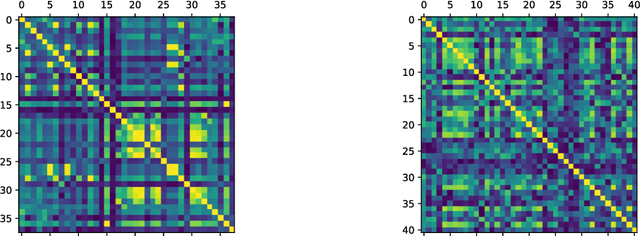
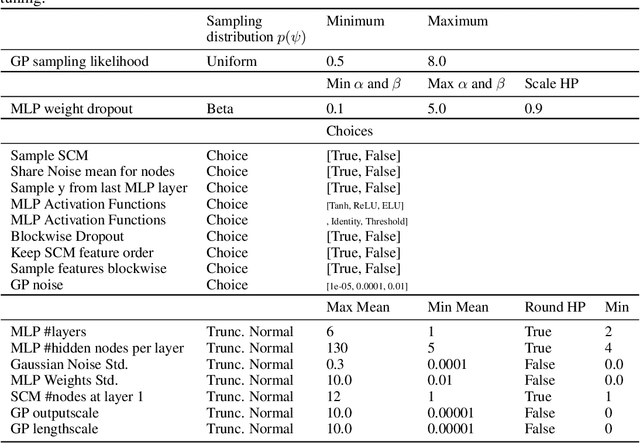
Abstract:We present TabPFN, an AutoML method that is competitive with the state of the art on small tabular datasets while being over 1,000$\times$ faster. Our method is very simple: it is fully entailed in the weights of a single neural network, and a single forward pass directly yields predictions for a new dataset. Our AutoML method is meta-learned using the Transformer-based Prior-Data Fitted Network (PFN) architecture and approximates Bayesian inference with a prior that is based on assumptions of simplicity and causal structures. The prior contains a large space of structural causal models and Bayesian neural networks with a bias for small architectures and thus low complexity. Furthermore, we extend the PFN approach to differentiably calibrate the prior's hyperparameters on real data. By doing so, we separate our abstract prior assumptions from their heuristic calibration on real data. Afterwards, the calibrated hyperparameters are fixed and TabPFN can be applied to any new tabular dataset at the push of a button. Finally, on 30 datasets from the OpenML-CC18 suite we show that our method outperforms boosted trees and performs on par with complex state-of-the-art AutoML systems with predictions produced in less than a second. We provide all our code and our final trained TabPFN in the supplementary materials.
Transformers Can Do Bayesian Inference
Jan 25, 2022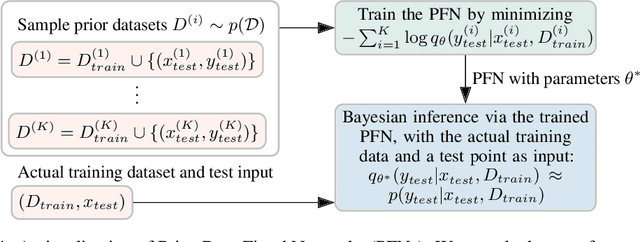



Abstract:Currently, it is hard to reap the benefits of deep learning for Bayesian methods, which allow the explicit specification of prior knowledge and accurately capture model uncertainty. We present Prior-Data Fitted Networks (PFNs). PFNs leverage large-scale machine learning techniques to approximate a large set of posteriors. The only requirement for PFNs to work is the ability to sample from a prior distribution over supervised learning tasks (or functions). Our method restates the objective of posterior approximation as a supervised classification problem with a set-valued input: it repeatedly draws a task (or function) from the prior, draws a set of data points and their labels from it, masks one of the labels and learns to make probabilistic predictions for it based on the set-valued input of the rest of the data points. Presented with a set of samples from a new supervised learning task as input, PFNs make probabilistic predictions for arbitrary other data points in a single forward propagation, having learned to approximate Bayesian inference. We demonstrate that PFNs can near-perfectly mimic Gaussian processes and also enable efficient Bayesian inference for intractable problems, with over 200-fold speedups in multiple setups compared to current methods. We obtain strong results in very diverse areas such as Gaussian process regression, Bayesian neural networks, classification for small tabular data sets, and few-shot image classification, demonstrating the generality of PFNs. Code and trained PFNs are released at https://github.com/automl/TransformersCanDoBayesianInference.
 Add to Chrome
Add to Chrome Add to Firefox
Add to Firefox Add to Edge
Add to Edge